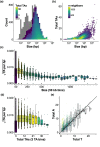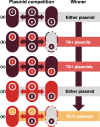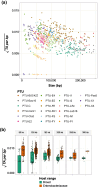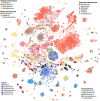Toxin-Antitoxin Systems Reflect Community Interactions Through Horizontal Gene Transfer
- PMID: 39404847
- PMCID: PMC11523183
- DOI: 10.1093/molbev/msae206
Toxin-Antitoxin Systems Reflect Community Interactions Through Horizontal Gene Transfer
Abstract
Bacterial evolution through horizontal gene transfer (HGT) reflects their community interactions. In this way, HGT networks do well at mapping community interactions, but offer little toward controlling them-an important step in the translation of synthetic strains into natural contexts. Toxin-antitoxin (TA) systems serve as ubiquitous and diverse agents of selection; however, their utility is limited by their erratic distribution in hosts. Here we examine the heterogeneous distribution of TAs as a consequence of their mobility. By systematically mapping TA systems across a 10,000 plasmid network, we find HGT communities have unique and predictable TA signatures. We propose these TA signatures arise from plasmid competition and have further potential to signal the degree to which plasmids, hosts, and phage interact. To emphasize these relationships, we construct an HGT network based solely on TA similarity, framing specific selection markers in the broader context of bacterial communities. This work both clarifies the evolution of TA systems and unlocks a common framework for manipulating community interactions through TA compatibility.
Keywords: community; horizontal gene transfer; network; plasmid; toxin–antitoxin system.
© The Author(s) 2024. Published by Oxford University Press on behalf of Society for Molecular Biology and Evolution.
Conflict of interest statement
Conflict of Interest The authors declare no competing financial interests.
Figures






Similar articles
-
A noncanonical intrinsic terminator in the HicAB toxin-antitoxin operon promotes the transmission of conjugative antibiotic resistance plasmids.Nucleic Acids Res. 2025 Feb 27;53(5):gkaf125. doi: 10.1093/nar/gkaf125. Nucleic Acids Res. 2025. PMID: 40036506 Free PMC article.
-
The higBA-Type Toxin-Antitoxin System in IncC Plasmids Is a Mobilizable Ciprofloxacin-Inducible System.mSphere. 2021 Jun 30;6(3):e0042421. doi: 10.1128/mSphere.00424-21. Epub 2021 Jun 2. mSphere. 2021. PMID: 34077263 Free PMC article.
-
Toxin-Antitoxin Systems as Phage Defense Elements.Annu Rev Microbiol. 2022 Sep 8;76:21-43. doi: 10.1146/annurev-micro-020722-013730. Epub 2022 Apr 8. Annu Rev Microbiol. 2022. PMID: 35395167 Review.
-
Toxin-Antitoxin Gene Pairs Found in Tn3 Family Transposons Appear To Be an Integral Part of the Transposition Module.mBio. 2020 Mar 31;11(2):e00452-20. doi: 10.1128/mBio.00452-20. mBio. 2020. PMID: 32234815 Free PMC article.
-
Bacterial Toxin-Antitoxin Systems' Cross-Interactions-Implications for Practical Use in Medicine and Biotechnology.Toxins (Basel). 2023 Jun 4;15(6):380. doi: 10.3390/toxins15060380. Toxins (Basel). 2023. PMID: 37368681 Free PMC article. Review.
Cited by
-
Assessing the Antibiotic Resistance in Food Lactic Acid Bacteria: Risks in the Era of Widespread Probiotic Use.Food Sci Nutr. 2025 Jul 31;13(8):e70740. doi: 10.1002/fsn3.70740. eCollection 2025 Aug. Food Sci Nutr. 2025. PMID: 40755505 Free PMC article. Review.
References
-
- Bastian M, Heymann S, Jacomy M. 2009. Gephi: an open source software for exploring and manipulating networks. Proceedings of the international AAAI Conference on Web and Social Media; May 17-20; San Jose, California, USA. p. 3.
MeSH terms
LinkOut - more resources
Full Text Sources

